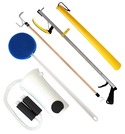
This resource is a video abstract of a research paper created by Research Square on behalf of its authors. It provides a synopsis that's easy to understand, and can be used to introduce the topics it covers to students, researchers, and the general public. The video's transcript is also provided in full, with a portion provided below for preview:
"When modern 3D printing was invented in the early 1980s, few could have predicted the influence it has today. At no other time in history has it been this easy to transform a sketch into the real thing. And while that feat has proven immensely useful for constructing complex machines, it is unlikely more meaningful anywhere else today than in the field of biomedicine. With the ability to churn out standard or custom prosthetics, devices, and even test models, the 3D printing of biomaterials is revolutionizing medical care. One of the greatest conveniences afforded by biomedical 3D printing is the ability to manufacture parts on demand. Common load-bearing prosthetics, such as those for knee or hip replacements, no longer have to be built in bulk and benched before use. Virtually stored print files can be called upon and processed into parts as soon as they are needed in the clinic, with the printing material and method suited to the part’s function and placement..."
The rest of the transcript, along with a link to the research itself, is available on the resource itself.
- Subject:
- Applied Science
- Engineering
- Material Type:
- Diagram/Illustration
- Reading
- Provider:
- Research Square
- Provider Set:
- Video Bytes
- Date Added:
- 09/27/2019
